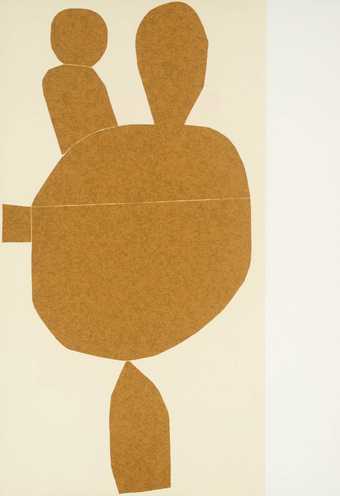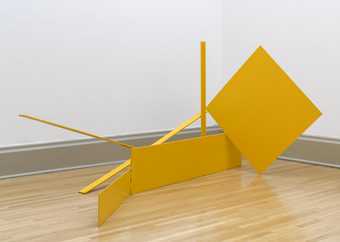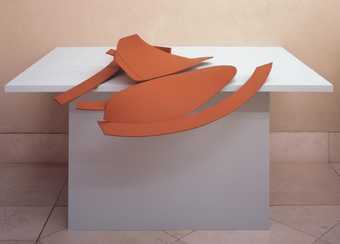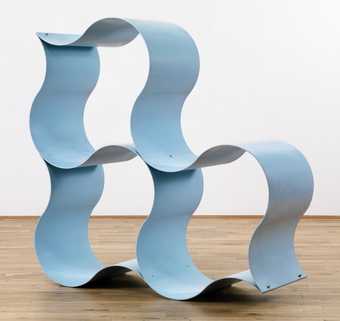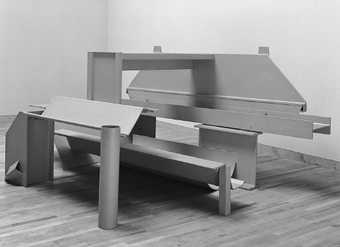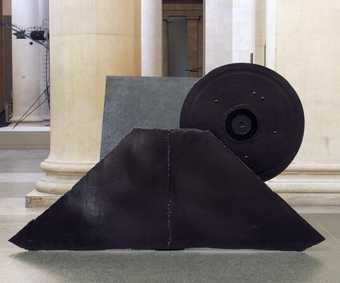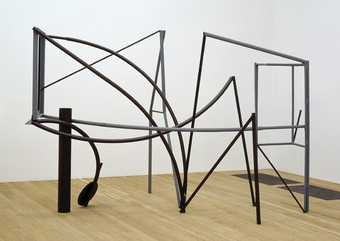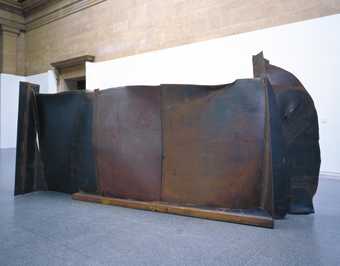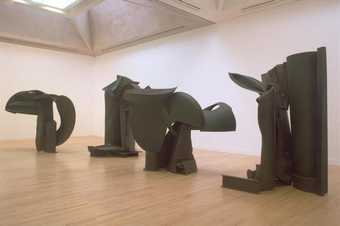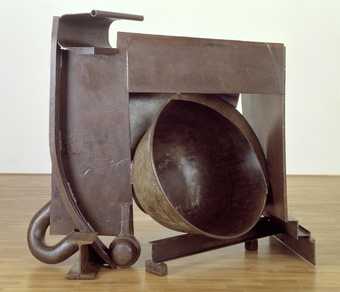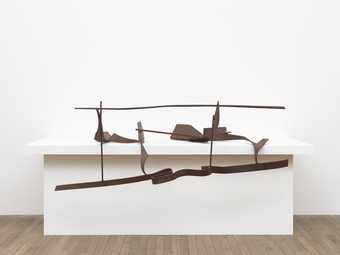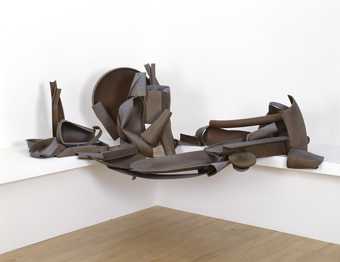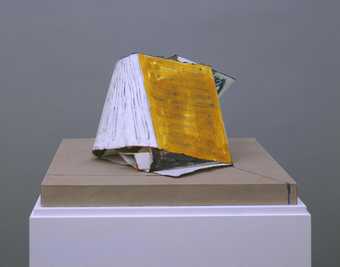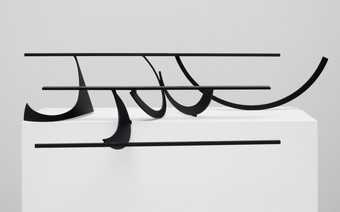
In Tate Liverpool
- Artist
- Sir Anthony Caro 1924–2013
- Medium
- Steel
- Dimensions
- Object: 590 × 1040 × 420 mm
- Collection
- Tate
- Acquisition
- Presented by the artist 2006
- Reference
- T12326
Summary
In 1966, after a rapid rise to prominence with large-scale, abstract works constructed from steel, Anthony Caro began making small sculptures which became a long-running discrete series, known as ‘table pieces’. Designed to sit on the edge of a horizontal surface at table height, they are neither maquettes nor models that can be scaled up and placed on the ground. Caro’s goal was to make small sculptures whose modest dimensions would be intrinsic to their final form. Often their component parts include handles, tools, objects or implements whose size is recognizably intended to fit into the human hand. However abstract Caro’s sculpture may appear to be, it is always related to the human body for, as he stated in a lecture on Degas, ‘all sculpture takes its bearings from the fact that we live inside our bodies and that our size and stretch and strength is what it is’ (quoted in Moorhouse, p.25).
Table Piece XXVIII consists of three elements welded together: a steel cylinder in the shape of a tin can, a rounded strip of steel, and a steel rod bent at 90 degrees in two places to form an ‘S’. On the bottom edge of the cylinder a small foot keeps the work balanced at a particular angle on the surface it is designed to overhang and which it touches at only one point. The cylinder and bent strip are so joined as to both point outwards and upwards, forming an open-ended ‘V’ that gives the work a sense of arrested movement in two directions. The basic materials are found objects, but the way in which they are joined is very deliberate. So too is the decision to establish a particular relationship with the viewer by ensuring that, by means of the small foot, Table Piece XXVIII is stable at a certain angle, and can only be seen, even in the mind, as a small sculpture for a table-top, that size and at that height, with one element falling below the top surface which would be impossible in a full-size piece on the ground. In keeping with its dynamic diagonals, suggestive of energy, the whole work is bright red.
Table Piece XXVIII is painted overall in burgundy. Colour was an important element in Caro’s sculpture in the late 1960s – usually red, yellow or green applied uniformly to all the constituent parts to create a visual unity. He was regularly in touch with several American modernist critics and abstract artists, and was a close friend of the painter Kenneth Noland (born 1924), a colleague at Bennington College in Vermont where Caro was a visiting lecturer during 1963–5. It was Noland who suggested reducing the complexity of individual pieces and, like the American sculptor David Smith (1906–65), working in series. Noland also helped choose the colours for Caro’s table pieces, an informal collaboration indicative of the spirit in which they were produced. Indeed the artist has said that ‘Making my table sculptures is fun, very loose’ (quoted in Barker, p.167). They were made in the evening and many, especially the later ones from the 1970s such as Writing Piece (Other) (L02547), have the graphic quality of quick sketches.
There are several table pieces in the Tate collection, from the 1960s, 1970s, and 1980s, of which Table Piece XXVIII is the earliest. In 1969 Caro was the first contemporary artist to show at the new Hayward Gallery in London, and this was also the first occasion on which his table pieces were exhibited together in the UK.
Further reading:
Paul Moorhouse (ed.), Anthony Caro, exhibition catalogue, Tate Britain, London 2005.
Ian Barker, Anthony Caro. Quest for the New Sculpture, Aldershot and Burlington, Vermont 2004.
The British Council, Anthony Caro: Table Sculptures 1966–77, exhibition catalogue, London 1977.
Valerie Holman
April 2009
Does this text contain inaccurate information or language that you feel we should improve or change? We would like to hear from you.
Explore
- abstraction(8,615)
-
- non-representational(6,161)
-
- colour(2,481)
- irregular forms(2,007)
- monochromatic(722)
You might like
-
Victor Pasmore [no title]
1971 -
Sir Anthony Caro Yellow Swing
1965 -
Sir Anthony Caro Early One Morning
1962 -
Sir Anthony Caro Piece LXXXII
1969 -
David Annesley Godroon
1966 -
Sir Anthony Caro Quartet
1971 -
Sir Anthony Caro Twenty Four Hours
1960 -
Sir Anthony Caro Emma Dipper
1977 -
Sir Anthony Caro Tundra
1975 -
Sir Anthony Caro Night Movements
1987–90 -
Sir Anthony Caro The Soldier’s Tale
1983 -
Sir Anthony Caro Table Piece CCLXVI
1975 -
Sir Anthony Caro Déjeuner sur l’herbe II
1989 -
Sir Anthony Caro #15 Point
1993 -
Sir Anthony Caro Table Piece LXXX
1969

